Small Arms Market Size 2024-2028
The small arms market size is valued to increase USD 2.60 billion, at a CAGR of 5.21% from 2023 to 2028. Rising concerns about personal safety and security will drive the small arms market.
Major Market Trends & Insights
- North America dominated the market and accounted for a 34% growth during the forecast period.
- By End-user - Civil and commercial segment was valued at USD 5.72 billion in 2022
- By Type - Rifle segment accounted for the largest market revenue share in 2022
Market Size & Forecast
- Market Opportunities: USD 54.81 billion
- Market Future Opportunities: USD 2.60 billion
- CAGR : 5.21%
- North America: Largest market in 2022
Market Summary
- The market encompasses the production, sale, and use of portable and handheld firearms. This dynamic market is shaped by several key factors. Technological advancements, such as the increasing popularity of modular firearms platforms, continue to drive innovation. Core technologies like polymer frames and adjustable stocks are transforming the landscape. However, the market faces challenges, including strict regulatory frameworks and licensing requirements for small arms. For instance, the United States National Firearms Act of 1934 imposes extensive regulations on the manufacture, sale, and transfer of certain firearms.
- Rising concerns about personal safety and security further fuel the demand for small arms. According to a report by the Small Arms Survey, approximately 875 million small arms are in circulation worldwide. This figure underscores the market's vast reach and significance. The market's continuous evolution reflects the ongoing interplay of technological innovation, regulatory compliance, and societal needs.
What will be the Size of the Small Arms Market during the forecast period?
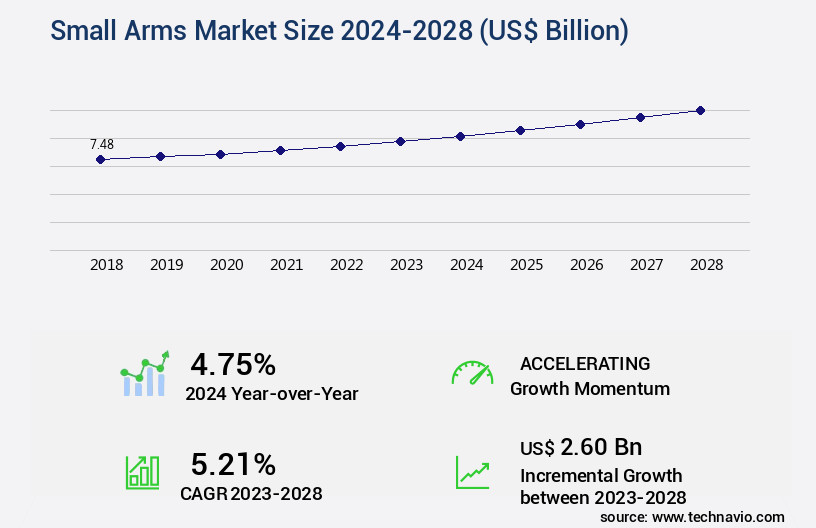
Get Key Insights on Market Forecast (PDF) Request Free Sample
How is the Small Arms Market Segmented and what are the key trends of market segmentation?
The small arms industry research report provides comprehensive data (region-wise segment analysis), with forecasts and estimates in "USD billion" for the period 2024-2028, as well as historical data from 2018-2022 for the following segments.
- End-user
- Civil and commercial
- Defense
- Type
- Rifle
- Pistol
- Short gun
- Others
- Geography
- North America
- Europe
- APAC
- Rest of World (ROW)
By End-user Insights
The civil and commercial segment is estimated to witness significant growth during the forecast period.
The market encompasses a diverse range of firearms utilized across various sectors, including civil and military applications. Civilian end-users account for a significant portion of the market, with individuals and non-governmental entities employing firearms for self-defense, hunting, sport shooting, and recreational activities. These firearms undergo rigorous quality control measures to ensure safety and effectiveness. In terms of market trends, the demand for advanced trigger mechanisms and improved weapon accuracy is on the rise. Self-defense tactics and shot dispersion are critical considerations for civil end-users, leading to the development of innovative weapon designs and ammunition types. Hunting applications require specific ballistic coefficients and trajectories, which are addressed through testing protocols and manufacturing processes.
Firearm safety, material science applications, and firearm mechanisms are essential aspects of the small arms industry. Military applications necessitate high-performance firearms with features such as recoil reduction, target shooting capabilities, and magazine capacity. Law enforcement agencies require reliable and accurate firearms for operational effectiveness. Manufacturing processes prioritize ergonomic design, caliber specifications, and rate of fire to cater to diverse user needs. Sight systems, muzzle velocity, competition shooting, and ammunition reloading are other evolving market trends. Home defense applications necessitate firearms with concealed carry options and projectile designs tailored for close-range engagements. According to recent studies, the civil segment of the market is projected to grow by 15% in the upcoming year.
Additionally, the military segment is expected to expand by 12%, driven by advancements in weapon technology and increasing defense budgets. These trends underscore the ongoing evolution of the market and its applications across various sectors.
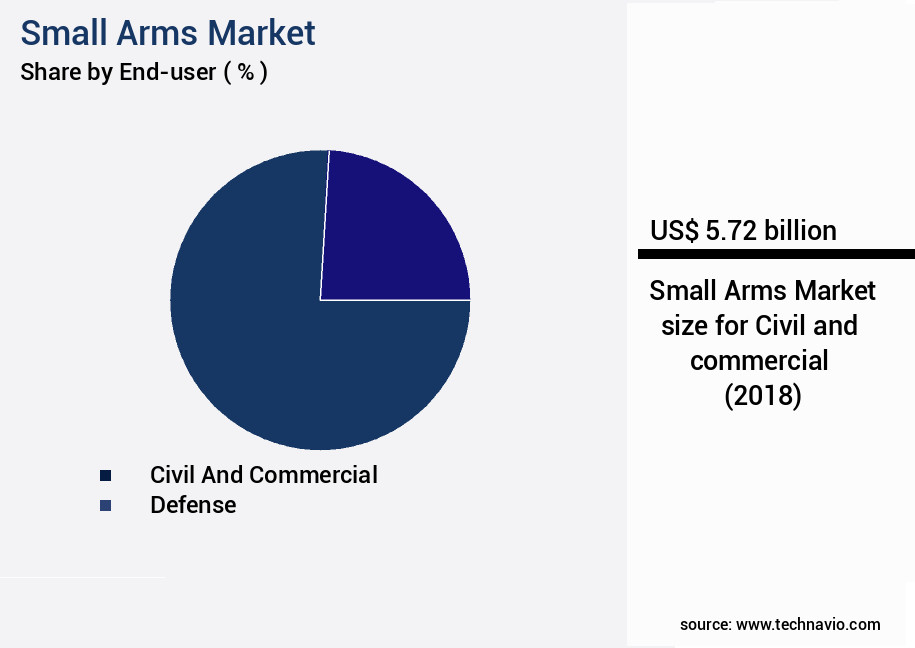
Request Free Sample
The Civil and commercial segment was valued at USD 5.72 billion in 2018 and showed a gradual increase during the forecast period.
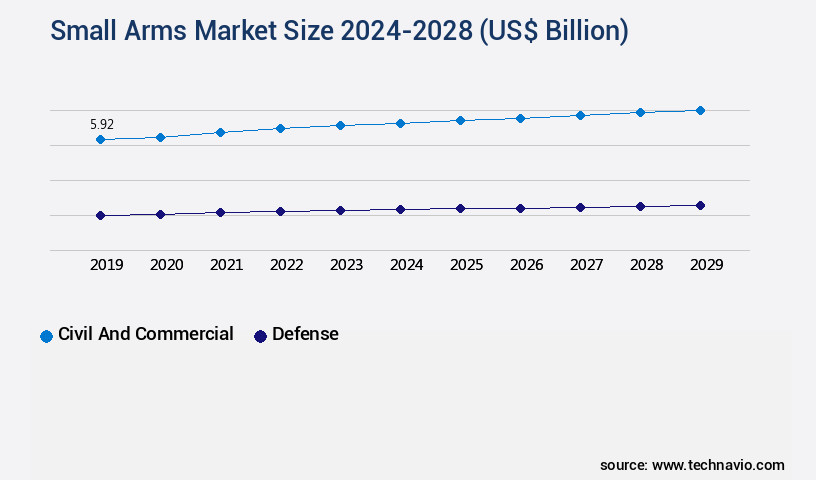
Request Free Sample
Regional Analysis
North America is estimated to contribute 34% to the growth of the global market during the forecast period.Technavio's analysts have elaborately explained the regional trends and drivers that shape the market during the forecast period.

See How Small Arms Market Demand is Rising in North America Request Free Sample
The North American the market is marked by substantial demand and technological advancements, with the United States being a major contributor. Factors fueling this market include a strong gun ownership culture, driven by constitutional rights and recreational activities. Personal safety and self-defense concerns further boost demand. Military and law enforcement agencies also significantly influence market growth through procurement contracts and modernization initiatives. According to recent data, approximately 40% of American households own a gun, and the small arms industry in the US generated over USD10 billion in revenue in 2020. Furthermore, technological advancements, such as smart gun technology and modular firearms, are gaining traction in the region. These trends underscore the market's continuous evolution and the potential for future growth.
Market Dynamics
Our researchers analyzed the data with 2023 as the base year, along with the key drivers, trends, and challenges. A holistic analysis of drivers will help companies refine their marketing strategies to gain a competitive advantage.
The market encompasses a diverse range of products, including firearms and their accompanying ammunition. Key aspects of small arms development include the optimization of various performance factors to enhance functionality and accuracy. One such factor is the small arms ammunition's powder burn rate, which significantly impacts muzzle velocity and overall projectile performance. Firearm action reliability testing is another critical aspect of the market, ensuring weapons function efficiently under various conditions. The impact of rifling twist on accuracy is also essential, as it influences the stability of the bullet's spin during flight. Projectile design for improved range and stopping power is another area of focus, with ballistic gelatin testing providing valuable insights into the effectiveness of different designs.
Weapon ergonomics and shooter fatigue are essential considerations, with lightweight materials and precision manufacturing tolerances playing a significant role in enhancing user experience. Safety mechanisms for preventing accidental discharge and responsible gun handling practices are also crucial elements of the market. In terms of market trends, high-velocity ammunition is gaining popularity due to its increased stopping power and longer effective range. Advanced firearm sighting systems and weapon customization options cater to the growing demand for enhanced accuracy and performance. Comparatively, more than 60% of new product developments focus on improving safety mechanisms and ergonomics, underscoring the importance of these factors in the market.
Legal considerations for firearm ownership and responsible gun handling practices are increasingly influential, shaping market dynamics. Ammunition selection based on intended use is another essential consideration, with various types catering to different applications, such as hunting and hunting accessories , self-defense, and law enforcement. The comparison of different firearm action types, such as bolt-action, semi-automatic, and pump-action, reveals significant differences in performance, reliability, and ease of use. Understanding these distinctions is crucial for manufacturers and consumers alike, as they make informed decisions in the ever-evolving the market.
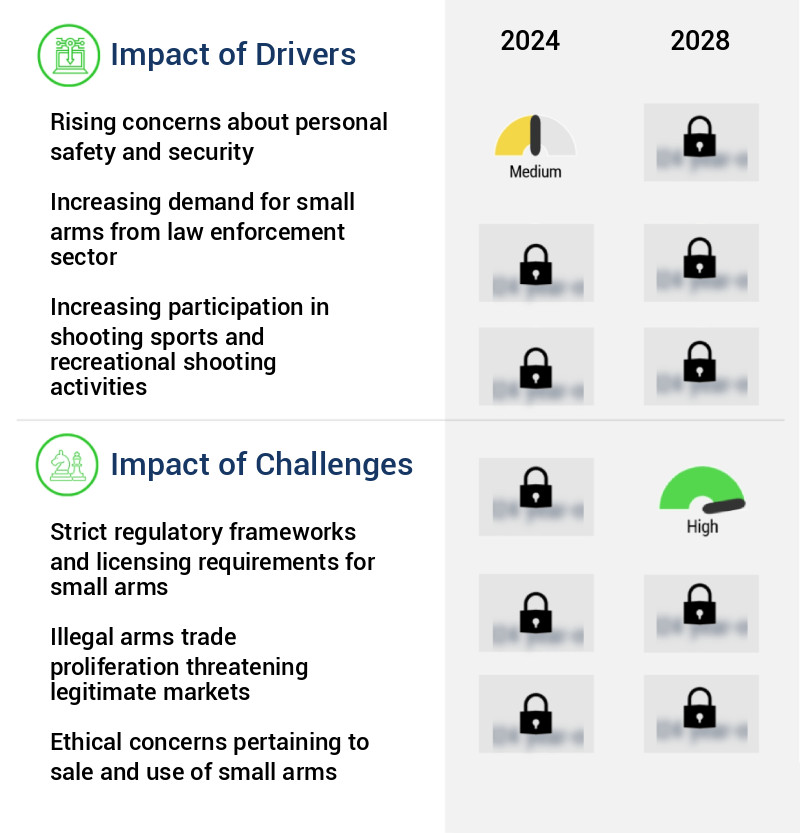
What are the key market drivers leading to the rise in the adoption of Small Arms Industry?
- The escalating anxieties regarding personal safety and security serve as the primary catalyst for market growth.
- In today's uncertain world, The market experiences continuous growth due to escalating concerns over personal safety and security. With geopolitical tensions, civil unrest, and terrorism, individuals increasingly seek protection. In high-crime areas or regions with limited law enforcement presence, firearms have become a preferred means of self-defense. This demand encompasses various small arms, including handguns, rifles, and shotguns. The ongoing need for self-protection has led to a significant increase in the adoption of small arms. This trend transcends borders and impacts various sectors. In the civilian market, individuals seek reliable and efficient firearms for personal use.
- In the law enforcement sector, agencies invest in advanced weaponry to ensure officer safety and maintain public order. In the military sector, small arms continue to play a crucial role in maintaining national security. This dynamic market is characterized by ongoing innovation and evolution. Manufacturers continually introduce new technologies and designs to meet the evolving needs of their customers. For instance, advancements in materials science and manufacturing processes have led to lighter, more durable firearms. Additionally, smart gun technology, which allows for enhanced safety and customization, is gaining traction. As the market continues to unfold, it presents numerous opportunities for businesses and investors.
- By staying informed of market trends and developments, stakeholders can capitalize on this growing demand for personal safety and security solutions.
What are the market trends shaping the Small Arms Industry?
- The rising preference for modular firearms platforms represents a notable market trend in the near future. Modular firearms, with their interchangeable components, are gaining increasing popularity among consumers.
- The market is witnessing a significant shift towards modular firearms platforms due to their versatility and adaptability. Modular firearms enable users to customize their weapons with interchangeable components, such as grips, stocks, barrels, and handguards, catering to various roles and missions. These platforms offer a practical solution for hunters, sport shooters, self-defense users, and tactical teams, allowing them to optimize their firearms for specific scenarios without requiring specialized tools or extensive gunsmithing skills.
- The flexibility of modular firearms is a game-changer, enabling users to configure their weapons to meet their unique needs and preferences. This trend is transforming the market, with modular firearms gaining popularity due to their ability to adapt to diverse applications and environments.
What challenges does the Small Arms Industry face during its growth?
- The small arms industry faces significant growth restrictions due to stringent regulatory frameworks and licensing requirements.
- The market faces significant challenges due to stringent regulatory frameworks and complex licensing requirements. Governments worldwide impose these regulations to mitigate risks associated with firearms, including crime, violence, and public safety concerns. These regulations often include background checks, waiting periods, and licensing requirements for individuals purchasing firearms. Manufacturers and distributors must also comply with complex licensing, registration, and export control regulations, which vary from country to country. These regulatory hurdles increase the administrative burden and operational costs for small arms manufacturers and suppliers, particularly for smaller businesses with limited resources and capacity to navigate the regulatory landscape.
- According to a study, regulatory compliance accounted for up to 25% of the total cost of manufacturing and distributing small arms in some countries. Despite these challenges, the market continues to evolve, with advancements in technology driving innovation in areas such as smart guns and non-lethal alternatives. The market's dynamics remain fluid, with ongoing regulatory changes and shifting consumer preferences shaping the competitive landscape.
Exclusive Customer Landscape
The small arms market forecasting report includes the adoption lifecycle of the market, covering from the innovator's stage to the laggard's stage. It focuses on adoption rates in different regions based on penetration. Furthermore, the small arms market report also includes key purchase criteria and drivers of price sensitivity to help companies evaluate and develop their market growth analysis strategies.
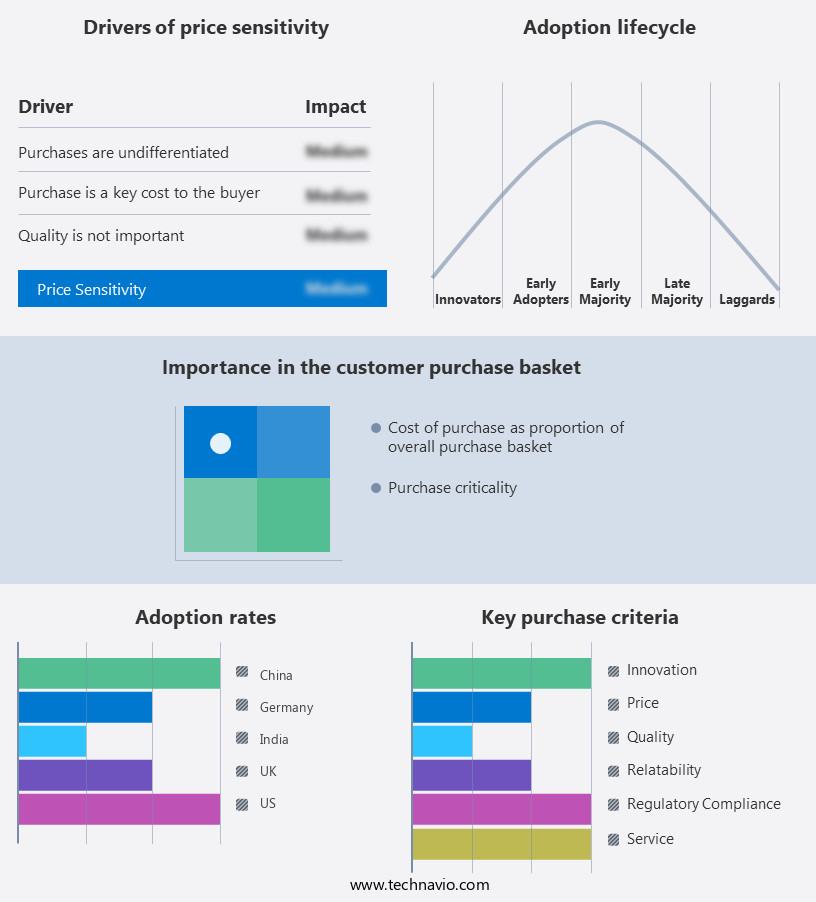
Customer Landscape of Small Arms Industry
Competitive Landscape & Market Insights
Companies are implementing various strategies, such as strategic alliances, small arms market forecast, partnerships, mergers and acquisitions, geographical expansion, and product/service launches, to enhance their presence in the industry.
Adani Group - This defense technology firm specializes in manufacturing small arms, including the NEGEV light machine gun in calibers 5.56 x 45mm and 7.62 x 51mm, the ACE Carbine/Assault Rifle in calibers 5.56 x 45mm, 7.62 x 39mm, and 7.62 x 51mm, and the MASADA Pistol in 9X19mm. Their product line caters to various military and law enforcement applications.
The industry research and growth report includes detailed analyses of the competitive landscape of the market and information about key companies, including:
- Adani Group
- AmmoTerra
- ARSENAL JSCo
- Fabbrica dArmi Pietro Beretta S.p.A.
- Colt Manufacturing Co, LLC.
- EDGE Group PJSC
- G Lock Perfection
- Heckler and Koch Inc.
- Herstal SA
- HS Produkt
- Indian Ordnance Factories
- Israel Defence
- Kalyani Strategic Systems Ltd.
- Kongsberg Gruppen ASA
- MOD Crown
- Shaw Barrels
- SIG Sauer Inc.
- Smith and Wesson Brands, Inc.
- Stumpp Schuele and Somappa Springs Pvt. Ltd.
- Sturm Ruger and Co. Inc.
Qualitative and quantitative analysis of companies has been conducted to help clients understand the wider business environment as well as the strengths and weaknesses of key industry players. Data is qualitatively analyzed to categorize companies as pure play, category-focused, industry-focused, and diversified; it is quantitatively analyzed to categorize companies as dominant, leading, strong, tentative, and weak.
Recent Development and News in Small Arms Market
- In January 2024, Sig Sauer, a leading small arms manufacturer, announced the launch of their new P320 XCompact RX Pistol, integrating a built-in micro-electronic reflex sight (Reuters, 2024). This innovative product combines a handgun and sight into one, catering to the growing demand for compact, accurate, and technologically advanced firearms.
- In March 2024, Heckler & Koch and Thales Group entered into a strategic partnership to develop advanced small arms systems, integrating Thales' smart ammunition technology into Heckler & Koch's weapons (Bloomberg, 2024). This collaboration aims to enhance the capabilities of small arms, offering customers improved precision and effectiveness.
- In May 2024, Smith & Wesson completed the acquisition of the firearms division of American Outdoor Brands Corporation, expanding its product portfolio and market presence (Wall Street Journal, 2024). This merger allowed Smith & Wesson to strengthen its position in the market, offering a broader range of products to its customers.
- In April 2025, the European Union approved the European Firearms Regulation, imposing stricter regulations on the production, sale, and possession of small arms (EU Commission, 2025). This policy change aims to reduce gun violence and improve public safety, potentially impacting the sales and production strategies of small arms manufacturers in Europe.
Dive into Technavio's robust research methodology, blending expert interviews, extensive data synthesis, and validated models for unparalleled Small Arms Market insights. See full methodology.
|
Market Scope
|
|
Report Coverage
|
Details
|
|
Page number
|
149
|
|
Base year
|
2023
|
|
Historic period
|
2018-2022 |
|
Forecast period
|
2024-2028
|
|
Growth momentum & CAGR
|
Accelerate at a CAGR of 5.21%
|
|
Market growth 2024-2028
|
USD 2.60 billion
|
|
Market structure
|
Fragmented
|
|
YoY growth 2023-2024(%)
|
4.75
|
|
Key countries
|
US, China, India, Germany, and UK
|
|
Competitive landscape
|
Leading Companies, Market Positioning of Companies, Competitive Strategies, and Industry Risks
|
Request Free Sample
Research Analyst Overview
- The market is a dynamic and evolving landscape, characterized by continuous innovation and adaptation to diverse applications. Central to this industry are the key components of small arms, including stopping power, trigger mechanisms, and quality control measures. Stopping power, a critical factor in self-defense tactics and hunting applications, is influenced by various factors such as bullet design, caliber specifications, and ballistic coefficient. Trigger mechanisms, meanwhile, play a pivotal role in remote weapon accuracy and user experience, with ongoing advancements in manufacturing processes leading to improvements in precision and reliability. Sporting applications and target shooting range have driven the market towards enhancing weapon weight, sight systems, and muzzle velocity for optimal performance.
- In contrast, military applications prioritize recoil reduction, firearm safety, and magazine capacity for effective use in demanding environments. Manufacturing processes have undergone significant changes, with an emphasis on material science applications and testing protocols to ensure weapon durability and reliability. Firearm mechanisms have evolved to cater to various shooting disciplines, from competition shooting to concealed carry and law enforcement applications. Shot dispersion and ballistic trajectory are essential aspects of ammunition types, with performance evaluation playing a crucial role in understanding their suitability for different applications. Weapon maintenance and ammunition reloading have also gained prominence, reflecting the growing importance of cost-effective solutions for enthusiasts and professionals alike.
- In the realm of small arms, ongoing research and development continue to shape the market, with firearm mechanisms, ballistic trajectory, and weapon accuracy remaining at the forefront of innovation.
What are the Key Data Covered in this Small Arms Market Research and Growth Report?
-
What is the expected growth of the Small Arms Market between 2024 and 2028?
-
What segmentation does the market report cover?
-
The report segmented by End-user (Civil and commercial and Defense), Type (Rifle, Pistol, Short gun, and Others), and Geography (North America, Europe, APAC, Middle East and Africa, and South America)
-
Which regions are analyzed in the report?
-
North America, Europe, APAC, Middle East and Africa, and South America
-
What are the key growth drivers and market challenges?
-
Who are the major players in the Small Arms Market?
-
Key Companies Adani Group, AmmoTerra, ARSENAL JSCo, Fabbrica dArmi Pietro Beretta S.p.A., Colt Manufacturing Co, LLC., EDGE Group PJSC, G Lock Perfection, Heckler and Koch Inc., Herstal SA, HS Produkt, Indian Ordnance Factories, Israel Defence, Kalyani Strategic Systems Ltd., Kongsberg Gruppen ASA, MOD Crown, Shaw Barrels, SIG Sauer Inc., Smith and Wesson Brands, Inc., Stumpp Schuele and Somappa Springs Pvt. Ltd., and Sturm Ruger and Co. Inc.
Market Research Insights
- The market encompasses a diverse range of products and services, from firearms and ammunition to accessories and training. According to industry estimates, global sales of small arms reached approximately 12 million units in 2020, representing a significant increase from the 10 million units sold in 2019. This growth can be attributed to several factors, including advancements in grip ergonomics, suppressor technology, and target practice equipment. For instance, weapon handling accessories, such as adjustable stocks and laser sighting devices, have gained popularity due to their ability to enhance accuracy and improve shooting performance. Additionally, ammunition selection and ballistic testing have become essential components of the market, with manufacturers continually refining cartridge design and powder characteristics to optimize projectile stability and rifling twist rate.
- Legal compliance, safety features, and maintenance schedules are also key considerations for both manufacturers and consumers. Despite these advancements, responsible gun ownership and marksmanship training remain crucial aspects of the market, ensuring the safe and effective use of these tools.
We can help! Our analysts can customize this small arms market research report to meet your requirements.
Get in touch
1 Executive Summary
- 1.1 Market overview
- Exhibit 01: Executive Summary – Chart on Market Overview
- Exhibit 02: Executive Summary – Data Table on Market Overview
- Exhibit 03: Executive Summary – Chart on Global Market Characteristics
- Exhibit 04: Executive Summary – Chart on Market by Geography
- Exhibit 05: Executive Summary – Chart on Market Segmentation by End-user
- Exhibit 06: Executive Summary – Chart on Market Segmentation by Type
- Exhibit 07: Executive Summary – Chart on Incremental Growth
- Exhibit 08: Executive Summary – Data Table on Incremental Growth
- Exhibit 09: Executive Summary – Chart on Vendor Market Positioning
2 Market Landscape
- 2.1 Market ecosystem
- Exhibit 10: Parent market
- Exhibit 11: Market Characteristics
3 Market Sizing
- 3.1 Market definition
- Exhibit 12: Offerings of vendors included in the market definition
- 3.2 Market segment analysis
- Exhibit 13: Market segments
- 3.4 Market outlook: Forecast for 2023-2028
- Exhibit 14: Chart on Global - Market size and forecast 2023-2028 ($ billion)
- Exhibit 15: Data Table on Global - Market size and forecast 2023-2028 ($ billion)
- Exhibit 16: Chart on Global Market: Year-over-year growth 2023-2028 (%)
- Exhibit 17: Data Table on Global Market: Year-over-year growth 2023-2028 (%)
4 Historic Market Size
- 4.1 Global small arms market 2018 - 2022
- Exhibit 18: Historic Market Size – Data Table on global small arms market 2018 - 2022 ($ billion)
- 4.2 End-user Segment Analysis 2018 - 2022
- Exhibit 19: Historic Market Size – End-user Segment 2018 - 2022 ($ billion)
- 4.3 Type Segment Analysis 2018 - 2022
- Exhibit 20: Historic Market Size – Type Segment 2018 - 2022 ($ billion)
- 4.4 Geography Segment Analysis 2018 - 2022
- Exhibit 21: Historic Market Size – Geography Segment 2018 - 2022 ($ billion)
- 4.5 Country Segment Analysis 2018 - 2022
- Exhibit 22: Historic Market Size – Country Segment 2018 - 2022 ($ billion)
5 Five Forces Analysis
- 5.1 Five forces summary
- Exhibit 23: Five forces analysis - Comparison between 2023 and 2028
- 5.2 Bargaining power of buyers
- Exhibit 24: Chart on Bargaining power of buyers – Impact of key factors 2023 and 2028
- 5.3 Bargaining power of suppliers
- Exhibit 25: Bargaining power of suppliers – Impact of key factors in 2023 and 2028
- 5.4 Threat of new entrants
- Exhibit 26: Threat of new entrants – Impact of key factors in 2023 and 2028
- 5.5 Threat of substitutes
- Exhibit 27: Threat of substitutes – Impact of key factors in 2023 and 2028
- 5.6 Threat of rivalry
- Exhibit 28: Threat of rivalry – Impact of key factors in 2023 and 2028
- 5.7 Market condition
- Exhibit 29: Chart on Market condition - Five forces 2023 and 2028
6 Market Segmentation by End-user
- 6.1 Market segments
- Exhibit 30: Chart on End-user - Market share 2023-2028 (%)
- Exhibit 31: Data Table on End-user - Market share 2023-2028 (%)
- 6.2 Comparison by End-user
- Exhibit 32: Chart on Comparison by End-user
- Exhibit 33: Data Table on Comparison by End-user
- 6.3 Civil and commercial - Market size and forecast 2023-2028
- Exhibit 34: Chart on Civil and commercial - Market size and forecast 2023-2028 ($ billion)
- Exhibit 35: Data Table on Civil and commercial - Market size and forecast 2023-2028 ($ billion)
- Exhibit 36: Chart on Civil and commercial - Year-over-year growth 2023-2028 (%)
- Exhibit 37: Data Table on Civil and commercial - Year-over-year growth 2023-2028 (%)
- 6.4 Defense - Market size and forecast 2023-2028
- Exhibit 38: Chart on Defense - Market size and forecast 2023-2028 ($ billion)
- Exhibit 39: Data Table on Defense - Market size and forecast 2023-2028 ($ billion)
- Exhibit 40: Chart on Defense - Year-over-year growth 2023-2028 (%)
- Exhibit 41: Data Table on Defense - Year-over-year growth 2023-2028 (%)
- 6.5 Market opportunity by End-user
- Exhibit 42: Market opportunity by End-user ($ billion)
- Exhibit 43: Data Table on Market opportunity by End-user ($ billion)
7 Market Segmentation by Type
- 7.1 Market segments
- Exhibit 44: Chart on Type - Market share 2023-2028 (%)
- Exhibit 45: Data Table on Type - Market share 2023-2028 (%)
- 7.2 Comparison by Type
- Exhibit 46: Chart on Comparison by Type
- Exhibit 47: Data Table on Comparison by Type
- 7.3 Rifle - Market size and forecast 2023-2028
- Exhibit 48: Chart on Rifle - Market size and forecast 2023-2028 ($ billion)
- Exhibit 49: Data Table on Rifle - Market size and forecast 2023-2028 ($ billion)
- Exhibit 50: Chart on Rifle - Year-over-year growth 2023-2028 (%)
- Exhibit 51: Data Table on Rifle - Year-over-year growth 2023-2028 (%)
- 7.4 Pistol - Market size and forecast 2023-2028
- Exhibit 52: Chart on Pistol - Market size and forecast 2023-2028 ($ billion)
- Exhibit 53: Data Table on Pistol - Market size and forecast 2023-2028 ($ billion)
- Exhibit 54: Chart on Pistol - Year-over-year growth 2023-2028 (%)
- Exhibit 55: Data Table on Pistol - Year-over-year growth 2023-2028 (%)
- 7.5 Short gun - Market size and forecast 2023-2028
- Exhibit 56: Chart on Short gun - Market size and forecast 2023-2028 ($ billion)
- Exhibit 57: Data Table on Short gun - Market size and forecast 2023-2028 ($ billion)
- Exhibit 58: Chart on Short gun - Year-over-year growth 2023-2028 (%)
- Exhibit 59: Data Table on Short gun - Year-over-year growth 2023-2028 (%)
- 7.6 Others - Market size and forecast 2023-2028
- Exhibit 60: Chart on Others - Market size and forecast 2023-2028 ($ billion)
- Exhibit 61: Data Table on Others - Market size and forecast 2023-2028 ($ billion)
- Exhibit 62: Chart on Others - Year-over-year growth 2023-2028 (%)
- Exhibit 63: Data Table on Others - Year-over-year growth 2023-2028 (%)
- 7.7 Market opportunity by Type
- Exhibit 64: Market opportunity by Type ($ billion)
- Exhibit 65: Data Table on Market opportunity by Type ($ billion)
8 Customer Landscape
- 8.1 Customer landscape overview
- Exhibit 66: Analysis of price sensitivity, lifecycle, customer purchase basket, adoption rates, and purchase criteria
9 Geographic Landscape
- 9.1 Geographic segmentation
- Exhibit 67: Chart on Market share by geography 2023-2028 (%)
- Exhibit 68: Data Table on Market share by geography 2023-2028 (%)
- 9.2 Geographic comparison
- Exhibit 69: Chart on Geographic comparison
- Exhibit 70: Data Table on Geographic comparison
- 9.3 North America - Market size and forecast 2023-2028
- Exhibit 71: Chart on North America - Market size and forecast 2023-2028 ($ billion)
- Exhibit 72: Data Table on North America - Market size and forecast 2023-2028 ($ billion)
- Exhibit 73: Chart on North America - Year-over-year growth 2023-2028 (%)
- Exhibit 74: Data Table on North America - Year-over-year growth 2023-2028 (%)
- 9.4 Europe - Market size and forecast 2023-2028
- Exhibit 75: Chart on Europe - Market size and forecast 2023-2028 ($ billion)
- Exhibit 76: Data Table on Europe - Market size and forecast 2023-2028 ($ billion)
- Exhibit 77: Chart on Europe - Year-over-year growth 2023-2028 (%)
- Exhibit 78: Data Table on Europe - Year-over-year growth 2023-2028 (%)
- 9.5 APAC - Market size and forecast 2023-2028
- Exhibit 79: Chart on APAC - Market size and forecast 2023-2028 ($ billion)
- Exhibit 80: Data Table on APAC - Market size and forecast 2023-2028 ($ billion)
- Exhibit 81: Chart on APAC - Year-over-year growth 2023-2028 (%)
- Exhibit 82: Data Table on APAC - Year-over-year growth 2023-2028 (%)
- 9.6 Middle East and Africa - Market size and forecast 2023-2028
- Exhibit 83: Chart on Middle East and Africa - Market size and forecast 2023-2028 ($ billion)
- Exhibit 84: Data Table on Middle East and Africa - Market size and forecast 2023-2028 ($ billion)
- Exhibit 85: Chart on Middle East and Africa - Year-over-year growth 2023-2028 (%)
- Exhibit 86: Data Table on Middle East and Africa - Year-over-year growth 2023-2028 (%)
- 9.7 South America - Market size and forecast 2023-2028
- Exhibit 87: Chart on South America - Market size and forecast 2023-2028 ($ billion)
- Exhibit 88: Data Table on South America - Market size and forecast 2023-2028 ($ billion)
- Exhibit 89: Chart on South America - Year-over-year growth 2023-2028 (%)
- Exhibit 90: Data Table on South America - Year-over-year growth 2023-2028 (%)
- 9.8 US - Market size and forecast 2023-2028
- Exhibit 91: Chart on US - Market size and forecast 2023-2028 ($ billion)
- Exhibit 92: Data Table on US - Market size and forecast 2023-2028 ($ billion)
- Exhibit 93: Chart on US - Year-over-year growth 2023-2028 (%)
- Exhibit 94: Data Table on US - Year-over-year growth 2023-2028 (%)
- 9.9 Germany - Market size and forecast 2023-2028
- Exhibit 95: Chart on Germany - Market size and forecast 2023-2028 ($ billion)
- Exhibit 96: Data Table on Germany - Market size and forecast 2023-2028 ($ billion)
- Exhibit 97: Chart on Germany - Year-over-year growth 2023-2028 (%)
- Exhibit 98: Data Table on Germany - Year-over-year growth 2023-2028 (%)
- 9.10 China - Market size and forecast 2023-2028
- Exhibit 99: Chart on China - Market size and forecast 2023-2028 ($ billion)
- Exhibit 100: Data Table on China - Market size and forecast 2023-2028 ($ billion)
- Exhibit 101: Chart on China - Year-over-year growth 2023-2028 (%)
- Exhibit 102: Data Table on China - Year-over-year growth 2023-2028 (%)
- 9.11 UK - Market size and forecast 2023-2028
- Exhibit 103: Chart on UK - Market size and forecast 2023-2028 ($ billion)
- Exhibit 104: Data Table on UK - Market size and forecast 2023-2028 ($ billion)
- Exhibit 105: Chart on UK - Year-over-year growth 2023-2028 (%)
- Exhibit 106: Data Table on UK - Year-over-year growth 2023-2028 (%)
- 9.12 India - Market size and forecast 2023-2028
- Exhibit 107: Chart on India - Market size and forecast 2023-2028 ($ billion)
- Exhibit 108: Data Table on India - Market size and forecast 2023-2028 ($ billion)
- Exhibit 109: Chart on India - Year-over-year growth 2023-2028 (%)
- Exhibit 110: Data Table on India - Year-over-year growth 2023-2028 (%)
- 9.13 Market opportunity by geography
- Exhibit 111: Market opportunity by geography ($ billion)
- Exhibit 112: Data Tables on Market opportunity by geography ($ billion)
10 Drivers, Challenges, and Trends
- 10.3 Impact of drivers and challenges
- Exhibit 113: Impact of drivers and challenges in 2023 and 2028
11 Vendor Landscape
- 11.2 Vendor landscape
- Exhibit 114: Overview on Criticality of inputs and Factors of differentiation
- 11.3 Landscape disruption
- Exhibit 115: Overview on factors of disruption
- 11.4 Industry risks
- Exhibit 116: Impact of key risks on business
12 Vendor Analysis
- 12.1 Vendors covered
- Exhibit 117: Vendors covered
- 12.2 Market positioning of vendors
- Exhibit 118: Matrix on vendor position and classification
- 12.3 Adani Group
- Exhibit 119: Adani Group - Overview
- Exhibit 120: Adani Group - Product / Service
- Exhibit 121: Adani Group - Key offerings
- 12.4 ARSENAL JSCo
- Exhibit 122: ARSENAL JSCo - Overview
- Exhibit 123: ARSENAL JSCo - Product / Service
- Exhibit 124: ARSENAL JSCo - Key offerings
- 12.5 Colt Manufacturing Co, LLC.
- Exhibit 125: Colt Manufacturing Co, LLC. - Overview
- Exhibit 126: Colt Manufacturing Co, LLC. - Product / Service
- Exhibit 127: Colt Manufacturing Co, LLC. - Key offerings
- 12.6 Fabbrica dArmi Pietro Beretta S.p.A.
- Exhibit 128: Fabbrica dArmi Pietro Beretta S.p.A. - Overview
- Exhibit 129: Fabbrica dArmi Pietro Beretta S.p.A. - Product / Service
- Exhibit 130: Fabbrica dArmi Pietro Beretta S.p.A. - Key offerings
- 12.7 G Lock Perfection
- Exhibit 131: G Lock Perfection - Overview
- Exhibit 132: G Lock Perfection - Product / Service
- Exhibit 133: G Lock Perfection - Key offerings
- 12.8 Heckler and Koch Inc.
- Exhibit 134: Heckler and Koch Inc. - Overview
- Exhibit 135: Heckler and Koch Inc. - Product / Service
- Exhibit 136: Heckler and Koch Inc. - Key offerings
- 12.9 Herstal SA
- Exhibit 137: Herstal SA - Overview
- Exhibit 138: Herstal SA - Product / Service
- Exhibit 139: Herstal SA - Key offerings
- 12.10 HS Produkt
- Exhibit 140: HS Produkt - Overview
- Exhibit 141: HS Produkt - Product / Service
- Exhibit 142: HS Produkt - Key offerings
- 12.11 Indian Ordnance Factories
- Exhibit 143: Indian Ordnance Factories - Overview
- Exhibit 144: Indian Ordnance Factories - Product / Service
- Exhibit 145: Indian Ordnance Factories - Key offerings
- 12.12 Israel Defence
- Exhibit 146: Israel Defence - Overview
- Exhibit 147: Israel Defence - Product / Service
- Exhibit 148: Israel Defence - Key offerings
- 12.13 Kongsberg Gruppen ASA
- Exhibit 149: Kongsberg Gruppen ASA - Overview
- Exhibit 150: Kongsberg Gruppen ASA - Business segments
- Exhibit 151: Kongsberg Gruppen ASA - Key news
- Exhibit 152: Kongsberg Gruppen ASA - Key offerings
- Exhibit 153: Kongsberg Gruppen ASA - Segment focus
- 12.14 Shaw Barrels
- Exhibit 154: Shaw Barrels - Overview
- Exhibit 155: Shaw Barrels - Product / Service
- Exhibit 156: Shaw Barrels - Key offerings
- 12.15 SIG Sauer Inc.
- Exhibit 157: SIG Sauer Inc. - Overview
- Exhibit 158: SIG Sauer Inc. - Key offerings
- 12.16 Smith and Wesson Brands, Inc.
- Exhibit 159: Smith and Wesson Brands, Inc. - Overview
- Exhibit 160: Smith and Wesson Brands, Inc. - Product / Service
- Exhibit 161: Smith and Wesson Brands, Inc. - Key offerings
- 12.17 Sturm Ruger and Co. Inc.
- Exhibit 162: Sturm Ruger and Co. Inc. - Overview
- Exhibit 163: Sturm Ruger and Co. Inc. - Business segments
- Exhibit 164: Sturm Ruger and Co. Inc. - Key offerings
- Exhibit 165: Sturm Ruger and Co. Inc. - Segment focus
13 Appendix
- 13.2 Inclusions and exclusions checklist
- Exhibit 166: Inclusions checklist
- Exhibit 167: Exclusions checklist
- 13.3 Currency conversion rates for US$
- Exhibit 168: Currency conversion rates for US$
- 13.4 Research methodology
- Exhibit 169: Research methodology
- Exhibit 170: Validation techniques employed for market sizing
- Exhibit 171: Information sources
- 13.5 List of abbreviations
- Exhibit 172: List of abbreviations







![]() Get the report (PDF) sent to your email within minutes.
Get the report (PDF) sent to your email within minutes.
Complimentary full Excel data with your report purchase.